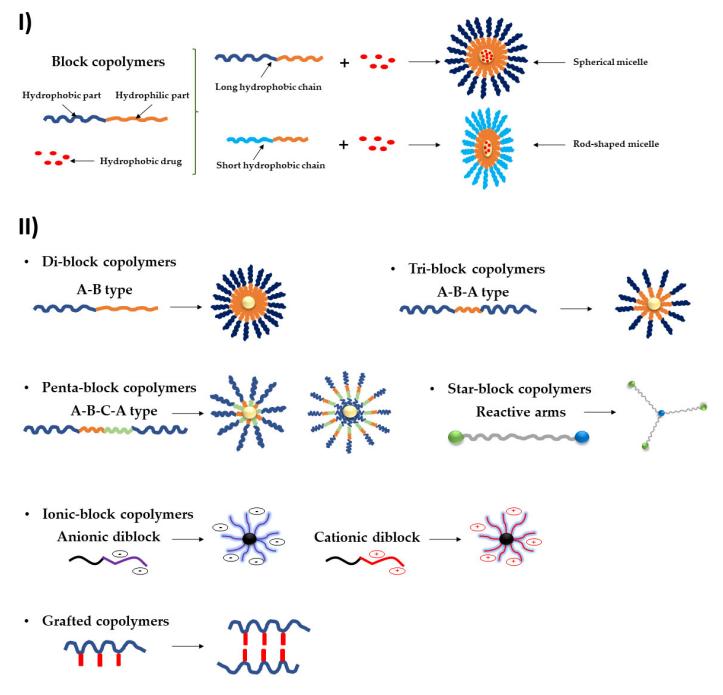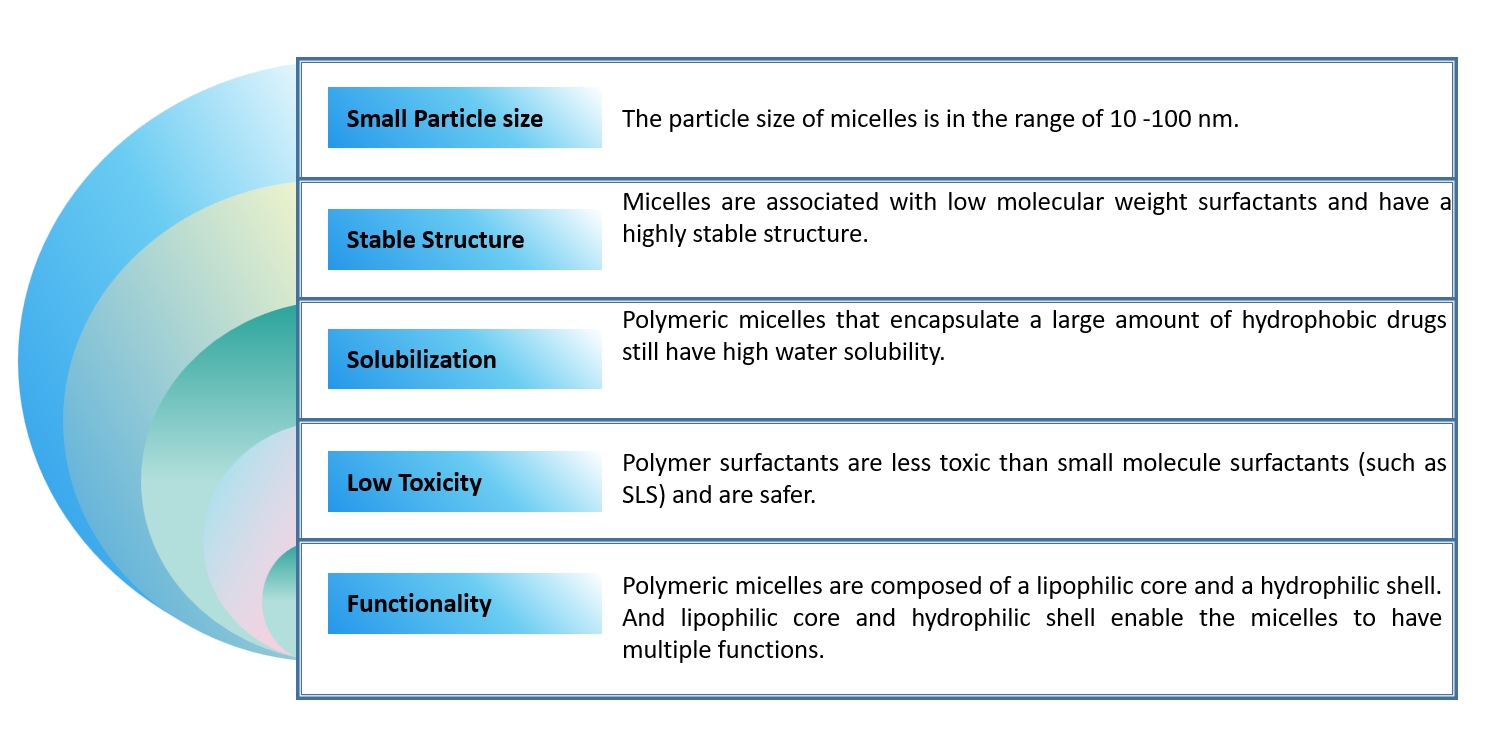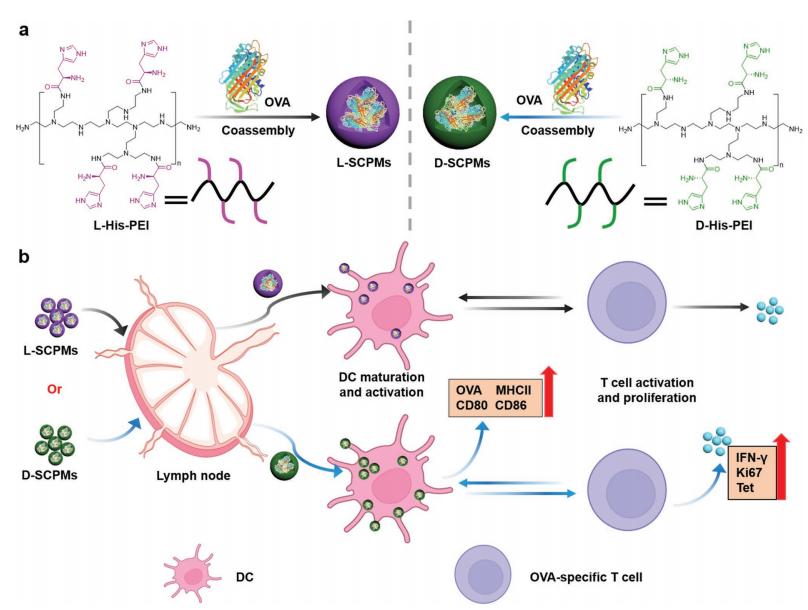Polymeric Micelle Development for Nanomedicine
Inquiry
Polymeric micelles are amphiphilic polymers that can self-assemble into nanomicelles with a core-shell structure in aqueous media. They have outstanding features such as thermodynamic and kinetic stability, dehydration storage, and natural hydration. They also has long circulation characteristics in the body, can target drugs to tumors and other tissues, and enhance cell membrane penetration. Therefore, They have been widely used in drug delivery. CD Formulation can provide you with polymeric micelle development services for nanomedicines to meet the different requirements based on our advanced polymeric micelle technology platform.
Types and Advantages of Polymeric Micelles
Polymeric micelles are thermodynamically stable colloidal solutions formed by self-assembly of synthetic amphiphilic block copolymers in water.
 Fig.1 The structure of polymeric micelles. (Irina Negut, et al. 2023)
Fig.1 The structure of polymeric micelles. (Irina Negut, et al. 2023)
According to the different principles of self-assembly, polymeric micelles can be divided into the following micelles:
Block Polymeric Micelles
Block polymeric micelles are composed of hydrophilic segments and hydrophobic segments. According to the number of hydrophobic segments and hydrophilic segments in the molecule, they are divided into diblock polymeric micelles and triblock polymeric micelles.
Polyelectrolyte Copolymeric Micelles
Polyelectrolyte copolymeric micelles are composed of a polyelectrolyte complex as the core and an uncharged block as the outer shell. They are complexes formed in solution when a block polyelectrolyte is mixed with another electrolyte polymer with opposite charge. Because polyelectrolytes have macromolecular segments and the ionization properties of small molecules, they can be used in sustained- and controlled-release drug delivery technology.
Non-Covalently Connected Micelles (NCCM)
Non-covalently connected micelles (NCCM) refer to polymeric micelles in which the core and shell are connected by non-covalent bonds. Different types of polymer segments can form strong non-covalent bonds through hydrogen bonds or metal coordination to form non-covalent polymers. Non-covalent bonds are reversible and synergistic, making non-covalently connected polymeric materials functional and responsive.
Graft Copolymeric Micelles
Graft copolymeric micelles are formed from an amphiphilic graft polymer. The backbone chain of the graft copolymer is lipophilic, while the branch chains are hydrophilic. When the graft copolymer is dispersed in an aqueous solution, it will self-assemble to form a nanocarrier with a core-shell structure. The lipophilic skeleton chain forms the micelle core, and the hydrophilic branch chain faces outward to form the outer shell.
 Fig.2 Advantages of polymeric micelles as drug delivery vehicles. (CD Formulation)
Fig.2 Advantages of polymeric micelles as drug delivery vehicles. (CD Formulation)
Explore Our Drug Loading Methods of Polymeric Micelles
CD Formulation is committed to researching drug loading methods of polymeric micelles including physical entrapment, chemical bonding, and electrostatic interaction. Physical entrapment and chemical bonding are mainly used to encapsulate small molecule drugs, while electrostatic interaction is mainly used to encapsulate charged nucleic acid drugs and protein drugs.
Physical Encapsulated Drug Loading
Physical encapsulated drug loading uses physical means to encapsulate drugs in the core of the micelle and uses the hydrophobicity of the core of the micelle and the hydrophobic interaction and hydrogen bonding force of the insoluble drug to solubilize the drug in the polymeric micelles.
Chemical Bonding Drug Loading
Chemical bonding drug loading is to connect the drug molecules to the hydrophobic ends of the amphiphilic polymer materials through chemical bonding. During the self-assembly of the materials to form micelles, the drugs connected to the hydrophobic ends directly enter the core of the micelles.
Electrostatic Drug Loading
Electrostatic drug loading is to tightly combine charged drugs with polymers through electrostatic interaction, and drug loading occurs during the formation of micelles. It is mainly used for the encapsulation of nucleic acid and protein drugs.
Our Polymeric Micelle Preparation Methods
The structure of polymer micelles itself is simple, and polymer micelles can usually be formed by self-assembly of the materials themselves in aqueous solutions. CD Formulation relies on our advanced design concept to use the following preparation methods for polymeric micelles.
Direct Dissolution
For polymers with good water solubility, we use direct dissolution method to prepare polymer micelles. When the polymer concentration is higher than the CMC, the polymer self-assembles into micelles with the help of gentle and continuous stirring in water.
Solvent Evaporation/Film Hydration
We prepare polymer micelles using thin film hydration/solvent evaporation techniques when the copolymers are soluble in volatile and water-miscible organic solvents.
Oil in Water Emulsion
When APIs and copolymers are soluble in water-immiscible organic solvents, we dissolve the hydrophobic functional ingredients and polymers in the organic solvent, stir vigorously, and homogenize to form an emulsion. The polymers rearrange to form a micellar structure, after which the organic phase of the emulsion evaporates to form a micellar solution.
Dialysis
When the water solubility of functional compounds and/or polymers is relatively poor, we will use dialysis method to prepare polymer micelles through solvent exchange.
In addition to the above preparation methods for polymeric micelles, CD Formulation is committed to explore advanced preparation technologies (such as ultrasound-assisted approach, solid dispersion technology, and supercritical fluid evaporation method) for polymeric micelles to provide professional support for researchers.
Our Quality Characterization of Polymeric Micelles
CD Formulation can also provide you with the following quality characterization services for polymeric micelles:
- Particle Size and Distribution
- Morphology
- Zeta Potential
- Targeting Ligands
- Drug loading
- Fraction of Drug That Surface-Associated
- Viscosity
- Osmolarity
- In Vitro Stability in Relevant Media
- In Vitro Degradation in Relevant Media
- In Vivo Release Rate and Place of Drug Release
- In Vivo Block Copolymer Degradation Rate and Place of Degradation
Why Choose Us to Develop Polymeric Micelles?
- With the help of our advanced polymeric micelle technology platform, our team has accumulated rich experience in the construction of block polymeric micelles, polyelectrolyte copolymeric micelles, non-covalently connected micelles, graft copolymeric micelles, etc. We can customize high-quality polymeric micelles for our customers.
- We have extensive expertise in drug-loading techniques and preparation technology for polymeric micelles. We can custom design appropriate drug loading methods and preparation technologies based on the formulation development needs of our clients, ensuring that the quality of polymeric micelle prototypes meets their specific requirements.
- We also have a lot of experience in the quality characterization of polymeric micelles including particle size and distribution, morphology, zeta potential, targeting ligands, drug loading viscosity, osmolarity, in vitro and in vivo evaluation, etc.
Published Data
Technology: Preparation of SCPMs by complexing OVA with His-PEI
Journal: Advanced Materials
IF: 29.4
Published: 2023
Results:
The authors studied the preparation of supramolecular chiral polymer micelles (SCPM) by complexing antigenic proteins with polyethylenimine modified with chiral amino acids. The introduction of chirality not only reduces the toxicity of cationic polymers, but also facilitates cellular uptake and antigen presentation. D-SCPM of antigenic protein self-assembly demonstrates chirality-mediated antigen processing and presentation. D-chirality-enabled immune activation opens new directions for the preparation of effective nanotherapeutics for disease prevention and treatment.
Here is a schematic illustration of the preparation of SCPMs and chirality-mediated antigen-specific immune activation.
a. Preparation of SCPMs by complexing OVA with His-PEI.
b. Enhanced antigen presentation, DC maturation, and activation as well as subsequent expressions of costimulatory molecules to trigger T-cell proliferation by D-SCPMs.
 Fig.3 Schematic illustrations of the preparation of SCPMs and chirality-mediated antigen-specific immune activation. (Hejin Jiang, et al. 2023)
Fig.3 Schematic illustrations of the preparation of SCPMs and chirality-mediated antigen-specific immune activation. (Hejin Jiang, et al. 2023)
Polymeric micelles show great promise in drug delivery because of their compact size, stable structure, ability to solubilize drugs, and low toxicity. CD Formulation is a leading expert in the development and research of polymeric micelles and formulations, thanks to our market expertise and professional experience. If you require our services, please contact us for detailed discussions.
References
- Irina Negut, Bogdan Bita. Polymeric Micellar Systems -- A Special Emphasis on "Smart" Drug Delivery. Pharmaceutics.2023, 15, 976.
- Hejin Jiang, Rui Liu, Lu Wang, et al. Chiral-Selective Antigen-Presentation by Supramolecular Chiral Polymer Micelles. Advanced Materials. 2023,35, 2208157.
How It Works
STEP 2
We'll email you to provide your quote and confirm order details if applicable.
STEP 3
Execute the project with real-time communication, and deliver the final report promptly.
Related Services

 Fig.1 The structure of polymeric micelles. (Irina Negut, et al. 2023)
Fig.1 The structure of polymeric micelles. (Irina Negut, et al. 2023) Fig.2 Advantages of polymeric micelles as drug delivery vehicles. (CD Formulation)
Fig.2 Advantages of polymeric micelles as drug delivery vehicles. (CD Formulation) Fig.3 Schematic illustrations of the preparation of SCPMs and chirality-mediated antigen-specific immune activation. (Hejin Jiang, et al. 2023)
Fig.3 Schematic illustrations of the preparation of SCPMs and chirality-mediated antigen-specific immune activation. (Hejin Jiang, et al. 2023)
